
Big Barnaby with his creator Matthew Armstrong. Photo: G. Jacobs.
There were past protestors inside the Canberra Museum and Gallery and there were current protestors outside for the launch of CMAG’s Activism: Forces for change in Canberra exhibition on Friday night (12 July). Then some inside protestors went outside, and everyone came back inside with their protest signs – to loud cheers.
The exhibition, curated by Rowan Henderson, records a long history of energetic local protest and covers everything from the women’s rights, same-sex marriage and the environment, to saving Glebe Park and spelling reform.
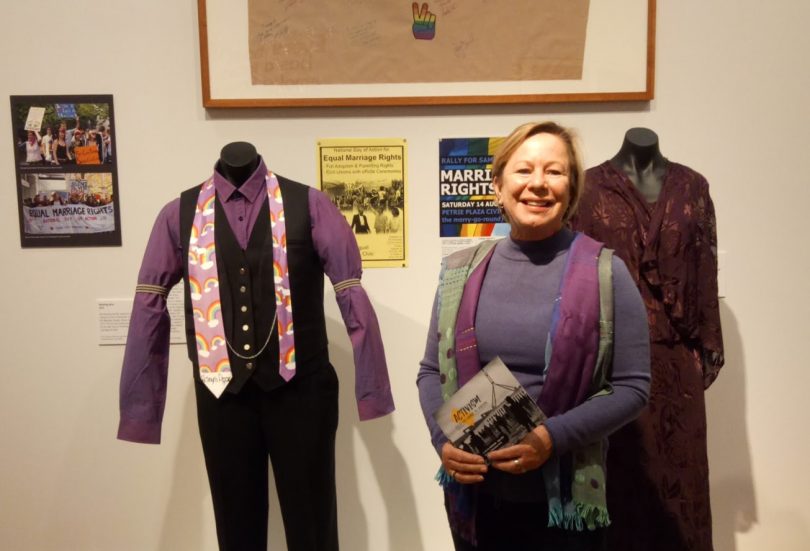
Veronica Wensing with her wedding outfits, marking the long-running protest movement for same-sex marriage. Photo: Cass Proudfoot.
That was the particular passion of Harry and Eva Lindgren, whose daughter Judith says they typified the socially engaged, activist post-war Canberran. “As a child I spent plenty of time with them on the median strip opposite the Lodge, protesting against Vietnam,” she recalled.
Harry Lindgren was a conscientious objector who saw out his war service on the Perth docks. A multi-linguist and expert on recreational mathematics, he and Eva were galvanised by the plight of adult migrants struggling with written English. So they embarked on a lifelong campaign to change the likes of “said” to “sed” and “through” to “thru”.
“My parents took themselves off to the Reid Tech so they could produce pamphlets on a second-hand offset printer in our front room,” Judith says.
They garnered support from the likes of Sir Mark Oliphant and Sir McFarland Burnett, and Judith suspects Harry and Eva would have been quite chuffed by today’s text speak and emoticons. “They had very active, fulfilled lives,” she says.
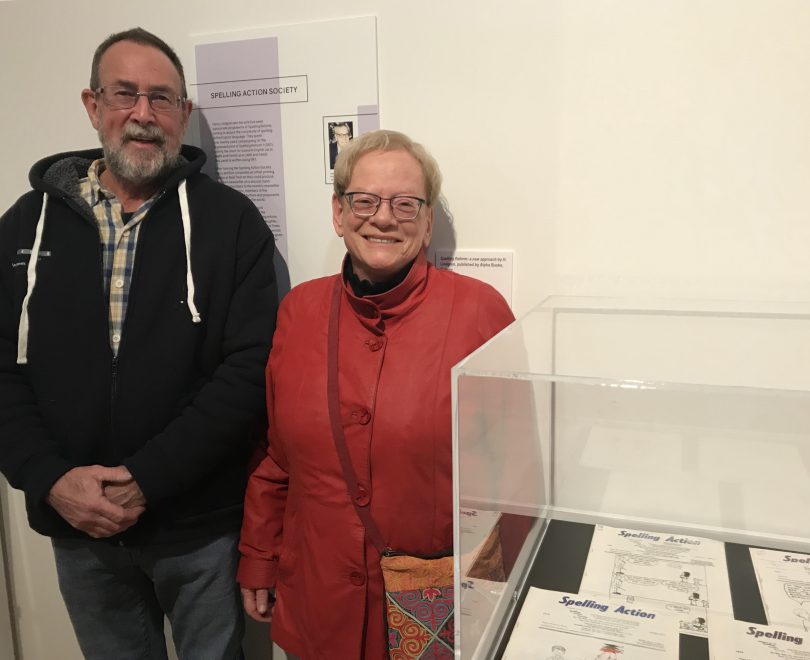
Chris Riddell and Judith Lindgren, celebrating the memory of their activist parents at CMAG’s exhibition opening. Photo: G Jacobs.
So did Di Riddell, who spent 30 years running the ANU Student Union, doing everything from making bail for student protestors to introducing condoms onto the campus. “Mum and Dad were both very community-minded and interested in helping people,” son Chris Riddell says.
“One in three girls were getting pregnant at the time, which meant many were missing out on the chance to finish their educations. Mum was ahead of her time in recognising that sex could be for fun, not just procreation. She brought the Corin Huts down for low-cost accommodation, she was a marriage celebrant, a JP, she set up the ANU arts centre with Dale McKelvey.”
When she died recently, a couple of those protesting students, Justice Richard Refshauge and former Canberra Times editor Jack Waterford both spoke at her funeral.
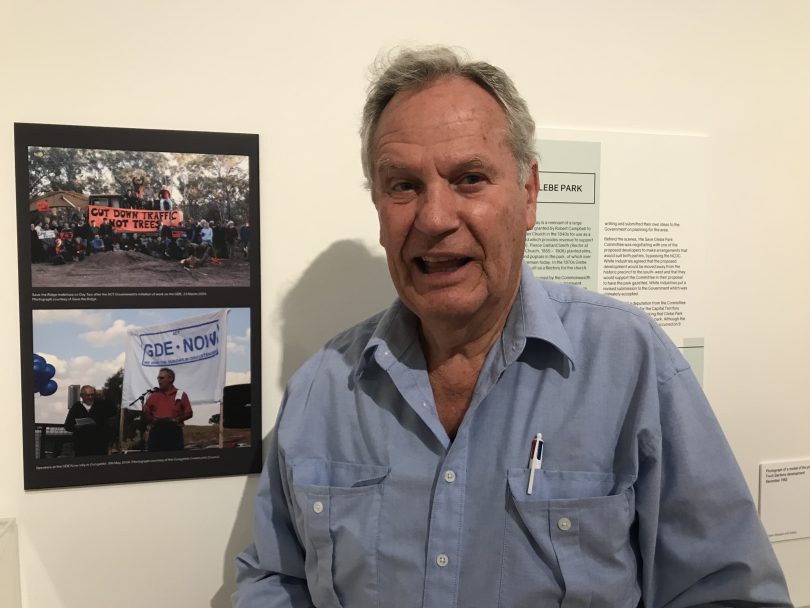
Peter Coggins with a photo of himself (red shirt, bottom) protesting for the Gungahlin Drive Extension. Photo: G Jacobs.
More recently, Peter Coggins (of Coggins Bakery family fame) got fired up by the Gungahlin Drive Extension which engendered vigorous local disagreement. “There was only one road in and out when I moved there,” he says. “The population grew to 40,000 and we were just about held hostage. But the ACT government had failed to get legal access to Crown land, so they couldn’t build the last stretch across the back of the O’Connor Ridge.”
Opposed by people tying themselves to trees to save the route, Coggins and the Gungahlin Community Council backed the eventually successful High Court challenge to make the GDE possible (many anti and pro-GDE campaigners later united behind light rail).
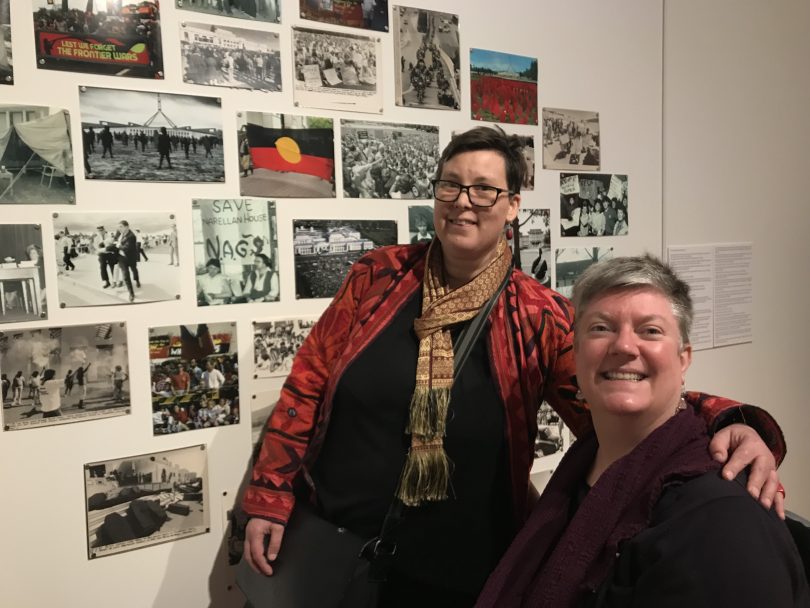
Yen Purkiss and fellow disability advocate Christina Ryan, from the Disability Leadership Institute. Photo: G Jacobs.
Yen Purkiss is on the autism spectrum and was stirred to action in 2012 when meeting a young autistic man who was “so disabled by other people’s negative views and expectations about what he couldn’t do – and it devastated me. I thought this is not what the diagnosis should be, it should be a liberation”.
Yen has since written seven books, done a TEDx talk and presented all over the world on positive thinking about cognitive disabilities. “I’m extremely passionate and will do this for the rest of my life”.

Dave Caffery, president of Music ACT, with the Soul Defender truck outside the Legislative Assembly. Photo: G Jacobs.
Outside, Music ACT protestors were projecting a counter onto the Assembly’s exterior. It tallies the days since the February 2009 Assembly report that identified the impossibility of co-locating apartments and hotels with live music venues, according to president Dave Caffery.
“In 2019 we still don’t have any action on this, but apartments and hotels are being approved that will shut down the music centre of this town because people can complain about noise levels when they have their windows open. That’s enough to close down a venue.”
The counter will remain on the Music ACT website until there’s legislative change, the Let Music Live campaign says.
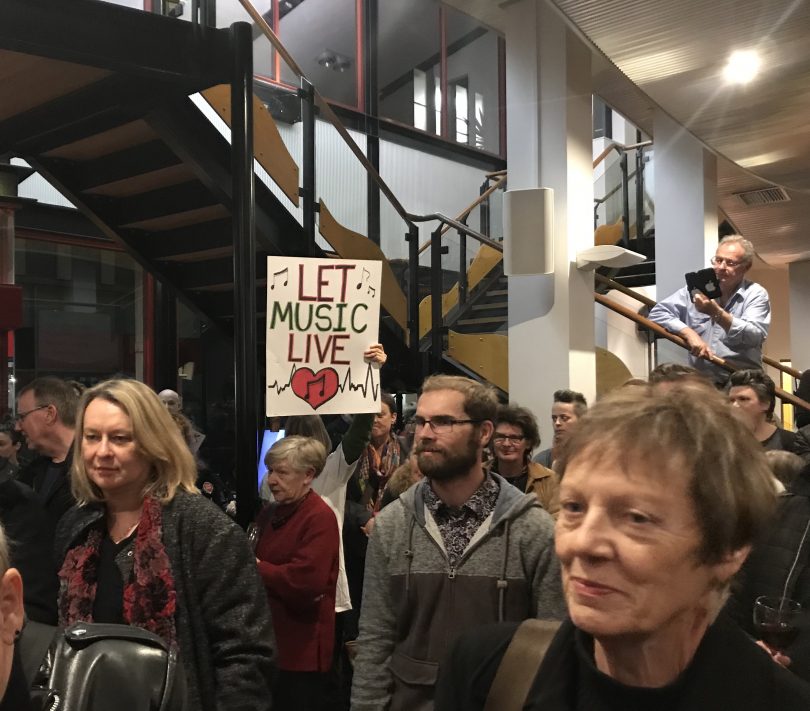
Let Music Live protestors are welcomed inside the Activism opening at CMAG. Photo: G Jacobs.
As Arts Minister Gordon Ramsay said at the launch, it all typifies the energy, enthusiasm and community dedication that’s intrinsic to Canberra’s character.
“There is no point at which you can say you’ve done enough,” says Yen. “We have to keep working to make a difference. Negatives come, there are setbacks and difficulties, but without activists, what would happen?”
Activism: Forces for change in Canberra is at Canberra Museum and Gallery until November 2.












